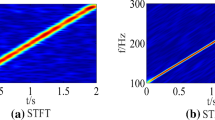Abstract
Owing to their effectiveness in underwater acoustic communication, linear frequency modulation (LFM) signals have been widely used in commercial and military applications. The existing approaches based on the traditional target function can estimate only single-component LFM signal parameters, as these approaches assume that the order of the optimal fractional Fourier transform (FRFT) is one. To overcome this limitation, we developed an LFM signal parameter estimation method that exploits the information entropy in its target function and optimizes the order of the FRFT using search algorithms, such as sequential search, multistage step search, and particle swarm optimization. Unlike existing solutions, the proposed technique can estimate both single and multicomponent LFM signal parameters. Experiments were performed to compare the proposed method with state-of-the-art techniques that rely on the maximum value, high-order cumulants, and fractional broadening target functions. The proposed approach was noted to be computationally more efficient and more accurate. Moreover, the parameter estimation precision of this approach was comparable to that of classic FRFT schemes.








Similar content being viewed by others
References
N. Dong, J. Wang, Sub-Nyquist sampling and parameters estimation of wideband LFM signals based on FRFT. Radioelectron. Commun. Syst. 61(8), 333–341 (2018). https://doi.org/10.3103/S0735272718080010
L.B. Guo, J.L. Tang, Y.Y. Dong et al., One-bit LFM signal recovery via random threshold strategy. Digit. Signal Process. 111(4), 102965 (2021). https://doi.org/10.1016/j.dsp.2021.102965
Q. Guo, F. Zhang, P. Zhou et al., Dual-band LFM signal generation by optical frequency quadrupling and polarization multiplexing. IEEE Photon. Technol. Lett. 29(16), 1320–1323 (2017). https://doi.org/10.1109/lpt.2017.2722004
J. Ji, S. Zheng, X. Zhang, Pre-distortion compensation for optical-based broadband LFM signal generation system. Opt. Commun. 435, 277–282 (2019). https://doi.org/10.1016/j.optcom.2018.11.059
L. Jiang, L. Li, G. Zhao et al., Instantaneous frequency estimation of nonlinear frequency-modulated signals under strong noise environment. Circuits Syst. Signal Process. 35(10), 3734–3744 (2016). https://doi.org/10.1007/s00034-015-0230-2
X. Liu, J. Han, C. Wang, B. Xiao, Parameters estimation for chirp signal based on QPF-FRFT. Optik 182, 529–537 (2019). https://doi.org/10.1016/j.ijleo.2019.01.063
X. Liu, J. Han, C. Wang, B. Xiao, Parameter estimation of linear frequency modulation signals based on sampling theorem and fractional broadening. Rev. Sci. Instrum. 90(1), 014702 (2019). https://doi.org/10.1063/1.5041031
X. Liu, B. Xiao, C. Wang, Frequency estimation of chirp signals based on fractional fourier transform combined with Otsu’s method. Optik 240, 166945 (2021). https://doi.org/10.1016/j.ijleo.2021.166945
H. Miao, F. Zhang, R. Tao, Mutual information rate of nonstationary statistical signals. Signal Process. 171, 107531 (2020). https://doi.org/10.1016/j.sigpro.2020.107531
S.S. Moghadasian, S. Gazor, Sparsely localized time-frequency energy distributions for multi-component LFM signals. IEEE Signal Process. Lett. 27, 6–10 (2020). https://doi.org/10.1109/LSP.2019.2951467
A. Moschitta, A. Comuniello, A.D. Angelis et al., Effect of noise, partial synchronization, and sampling frequency inaccuracies on amplitude measurement of multiple Linear Chirp signals. Measurement 181(3), 109635 (2021). https://doi.org/10.1016/j.measurement.2021.109635
S. Nandi, D. Kundu, Estimation of parameters in random amplitude chirp signal. Signal Process. 168, 107328 (2020). https://doi.org/10.1016/j.sigpro.2019.107328
H.M. Ozaktas, O. Arikan, M.A. Kutay, G. Bozdagt, Digital computation of the fractional Fourier transform. IEEE Trans. Signal Process. 44(9), 2141–2150 (1996). https://doi.org/10.1109/78.536672
J. Song, Y. Liu, Parameter estimation of LFM signal by direct and spline interpolation based on FrFT. 2012 Int. Conf. Inf. Technol. Softw. Eng. 210, 41–48 (2013). https://doi.org/10.1007/978-3-642-34528-9_5
H. Su, Q. Bao, Z. Chen, ADMM–Net: a deep learning approach for parameter estimation of chirp signals under sub-Nyquist sampling. IEEE Access 99, 1–1 (2020). https://doi.org/10.1109/ACCESS.2020.2989507
H.Q. Wang, P.B. Wang, S.Z. Wang et al., Study of intelligent optimization methods applied in the fractional Fourier transform. Adv. Mater. Res. 461, 323–328 (2012). https://doi.org/10.4028/www.scientific.net/AMR.461.323
S. Zhang, Y. Guo, W. Huo, W. Hou, FRFT-HOC based method of LFM parameter estimation. J. Signal Process. 29(2), 165–170 (2013)
H. Zhu, H. Sun, B. Jones et al., Wideband dual-polarized multiple beam-forming antenna arrays. IEEE Trans. Antennas Propag. 67(3), 1590–1604 (2019). https://doi.org/10.1109/TAP.2018.2888728
Funding
This work was supported by China’s Postdoctoral Science Foundation under Project no. 2020M673606XB.
Author information
Authors and Affiliations
Corresponding authors
Ethics declarations
Conflict of interest
The authors declare that they have no conflict of interest.
Additional information
Publisher's Note
Springer Nature remains neutral with regard to jurisdictional claims in published maps and institutional affiliations.
Rights and permissions
About this article
Cite this article
Liu, X., Xiao, B. & Wang, C. Optimal Target Function for the Fractional Fourier Transform of LFM Signals. Circuits Syst Signal Process 41, 4160–4173 (2022). https://doi.org/10.1007/s00034-022-01977-w
Received:
Revised:
Accepted:
Published:
Issue Date:
DOI: https://doi.org/10.1007/s00034-022-01977-w




